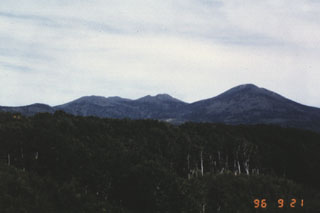Report on Hakkodasan (Japan) — June 1997
Bulletin of the Global Volcanism Network, vol. 22, no. 6 (June 1997)
Managing Editor: Richard Wunderman.
Hakkodasan (Japan) Volcanogenic carbon dioxide kills soldiers in a topographic depression
Please cite this report as:
Global Volcanism Program, 1997. Report on Hakkodasan (Japan) (Wunderman, R., ed.). Bulletin of the Global Volcanism Network, 22:6. Smithsonian Institution. https://doi.org/10.5479/si.GVP.BGVN199706-283280
Hakkodasan
Japan
40.659°N, 140.877°E; summit elev. 1585 m
All times are local (unless otherwise noted)
On 14 July press reports noted that a party of the Ground Self Defense Force (Japanese army) on a training mission at the N foot of Hakkoda volcano without gas masks accidentally inhaled dangerous gases. In the darkness, some members of the party slipped into a depression (18 m long, 11 m wide, and 8 m deep), as did those who first tried to rescue them. The men were hospitalized on the evening of 12 July, but three lost their lives. There were no plants within the depression, and leaves on plants around it were dead. The fire station of the Aomori Prefecture mentioned that many holes and depressions emitting sulfurous acidic gases were located around this volcano. Local farmers reported dead animals in these depressions.
According to J. Hirabayashi, who inspected the depression on 13 July, its gases contained as much as 15-20 volume percent CO2 (much higher than the normal value of 0.035%), but no hydrogen sulfide. Delta 13C values were -5.7 for CO2 in the gas from the depression collected on 13 July, -6.1 for CO2 dissolved in water samples from the Hakkoda hotsprings, and -6.0 in the springwater from near the depression, collected on 14 July. These results indicated a magmatic origin for the CO2-rich gas because delta 13C of CO2 in volcanic gas in Japan ranges from -10 to 0 , whereas that in CO2 gas of organic origin ranges from -30 to -20 .
Geological Summary. The basaltic-to-rhyolitic Hakkodasan volcano includes at least 17 stratovolcanoes and lava domes south of Mutsu Bay at the northern end of Honshu. The NE rim of an 8-km-wide Pleistocene caldera forms an arcuate ridge across a flat caldera-floor moat NE of the Hakkoda group volcanoes, which bury the SE caldera wall. A northern group of volcanoes, constructed within the caldera, appears to be younger than the southern group. Hakkoda-Odake, Ido-dake, and Tsurugi-dake have well-preserved craters. Akakuradake has a 1-km-wide explosion crater breached to the north. No historical eruptions are known, although an active solfatara occurs at Idodake, and hot springs are found at several locations within the caldera. Three minor phreatic eruptions were documented from Jigokunuma on the SW flank of Odake volcano from the 13th-17th centuries. Three soldiers on a training mission in July 1997 were killed by inhalation of volcanic gas.
Information Contacts: Takeshi Ohba and Jun-ichi Hirabayashi, Tokyo Institute of Technology, 2-12-1 O-okayama,Meguro-ku, Tokyo 152, Japan; Setsuya Nakada, Volcano Research Center, Earthquake Research Institute, University of Tokyo, Yayoi 1-1- 1, Bunkyo-ku, Tokyo 113, Japan (URL: http://www.eri.u-tokyo.ac.jp/VRC/index_E.html).

